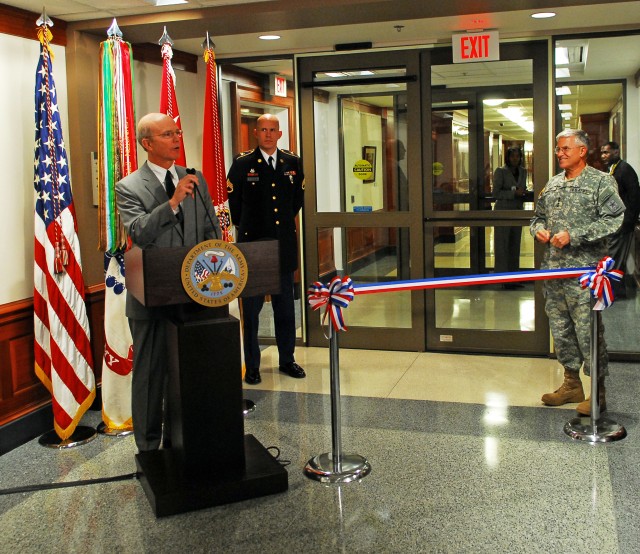WASHINGTON (Army News Service, Dec. 15, 2008) - The corridors of the Pentagon opened Monday to the Army's "Living History" exhibit which features more than 400 historical artifacts, some 80 pieces of original artwork and hundreds of photographs and films that tell the history of the American Soldier since the Army's birth on June 14, 1775.
At the ribbon-cutting ceremony Secretary of the Army Pete Geren and Army Chief of Staff George W. Casey Jr. spoke on the importance of the exhibit and how it will allow viewers to enter into a deeper understanding of the contributions of Soldiers past and present, from Yorktown, Va., to the Afghanistan mountains.
"It is important to an institution such as ours to stop and reflect on our past - to reflect on our great history," said Geren. "When you reflect on that history you cannot help but wonder how different the history of our nation would be, in fact how different the history of the world would be if not for the United States Army."
The chronological walk-through exhibit was prepared using artifacts and information from throughout the Army Museum System and the Army History Program. More than 70 companies and individuals provided materials and artifacts for the exhibit which was assembled and presented by the Army Heritage and Education Center.
"This is the first time that the Pentagon has seen an exhibit with such a sweeping scope," said Col. Robert J. Dalessandro, director of the Army Heritage and Education Center at Carlisle Barracks, Pa. "Far from focusing on battles, the exhibit shows the Army's involvement as a leader in exploration of the land, builder of infrastructure and leader in technology and social change."
Dalessandro said the 10,000-square-foot exhibit - the size of a small museum -- was put together in 67 days and consists of 39 cases. It includes artwork from Army combat artists that go back to World War I when the Army first began placing artists in the field.
Army Art Curator Renee Klish said the service had eight artists in World War I, more than 40 in World War II , and more than 50 in Vietnam.
"Since World War I, the artists have been told to paint in whatever style or medium they wished, as long as the subject was recognizable and as long as they understood they weren't there to paint an official portrait of the general," she said. "We also added another caveat saying that no one tells the artist what to paint or what to draw. The whole idea is to get the Soldiers and the reaction of the artist on paper or canvas and express what they lived."
A few of the featured exhibits include:
Aca,!Ac Dr. Bodo Otto compass: Otto was the senior surgeon of the general hospital at Valley Forge who served with Gen. George Washington throughout the Revolution. Otto established a system for mass inoculation of Soldiers against smallpox. The compass was donated to the Army by Otto's descendants.
Aca,!Ac The Girandoni Air Rifle: Designed and manufactured in Vienna, Austria in the 1780s, the weapon fits the description of the air rifle taken by the Corps of Discovery on their expedition in 1803-1806. The rifle has the marks of use and repairs consistent with the descriptions in the Lewis and Clark journals.
Aca,!Ac World War I Signal Pigeon "President Wilson:" The pigeon served with the Tank Corps at St. Mihiel, France where it carried critical messages identifying the location of enemy machine-gun positions that were blocking the American advance. Homing pigeons were used to carry messages between units, direct the delivery or cessation of artillery fire and provide locations of enemy units or other critical information.


Social Sharing